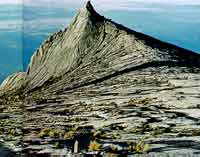
| Kinabalu Park |
|
Mount Kinabalu or the summit of Borneo is located in the East Malaysian state of Sabah. Visible from anywhere on the west coast of Sabah, the mountain stands out like a beacon and seems to call out to the adventurous to come and visit her. Standing at a height of 4,095 metres, it is the highest point between the Himalayas and Irian Jaya, and also among the youngest non-volcanic mountains in the world. The mountain forms the main focal point of the Kinabalu Park and draws visitors from all walks of life-trekkers, botanists, bird watchers, rock climbers and anyone seeking cool, refreshing climate. The Kinabalu Park, which covers an area of 7,537 sq.km., abounds with a wealth of flora. Plants from various parts of the world can be found here. Over 1,200 species of orchids are found in the Park together with many endemic species of rhododendrons, oaks, chestnuts and other plants. It is the centre for the curious pitcher plants. History Although there were earlier treks up Kinabalu,the official record of the first ascent is attributed to Sir Hugh Low, a former British Resident of Malaya, who scaled the mountain in 1851. He, however, did not make it to the summit. This feat was accomplished by John Whitehead, a zoologist who reached it in 1888. The highest point Low's Peak and numerous plants and orchids have, however been named in Low's honour. The mountain was gazetted as a park in 1964 because of its incredibly rich flora and fauna. With the construction of the road from Kota Kinabalu to Ranau, the number of visitors has increased significantly The surrounding hillside of Kinabalu have also been cultivated with temperate vegetables and flowers which find a ready market in the neighbouring countries. |
 Introduction
Introduction